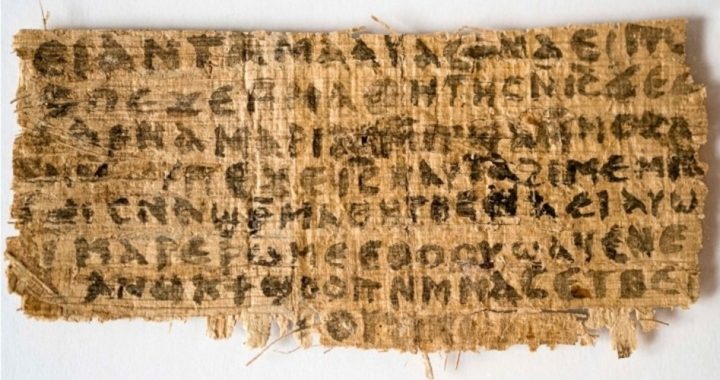
A supposedly ancient fragment of papyrus that a Harvard professor claimed has Jesus Christ referring to his “wife,” is most likely a fake, multiple scholars and experts have determined. According to the September 18 issue of the UK’s Guardian newspaper, Karen King, a professor of early Christianity at Harvard University, said the fragment is from the third or fourth century A.D. and contains text in which Jesus refers to “my wife,” whom he identifies as Mary. “King helped translate and unveiled the tiny fragment at a conference of Coptic experts in Rome,” reported the Guardian. “She said it doesn’t prove Jesus was married but speaks to issues of family and marriage that faced Christians.”
Some Bible scholars speaking up since the unveiling of the fragment have said that the relic is probably little more than an ingenious fake. Professor Francis Watson of the UK’s Durham University, who studied the fragment, said the relic is nothing more than a a patchwork of texts from a non-canonical Coptic-language Gospel of Thomas, which have been reassembled to suggest that Jesus had a wife.
In a paper published online, reported the Guardian in a subsequent article, “Watson argues that all of the sentence fragments found on the papyrus fragment have been copied, sometimes with small alterations, from printed editions of the Gospel of Thomas.” Watson said that he would be “very surprised if it were not a modern forgery, although it is possible that it was composed in this way in the fourth century.”
The Guardian reported that there are four words in the one-and-one-half inch by three-inch fragment offering “the first evidence that some early Christians believed Jesus had been married, King said. Those words, written in a language of ancient Egyptian Christians, translate to ‘Jesus said to them, my wife,’ King said in a statement.”
While Scripture offers no evidence that Jesus married, and Christian dogma has always reenforced the understanding that, as God the Son, Jesus remained celibate, King used the announcement as an opportunity to frame the issue as an unresolved debate. This supposedly new discovery, she declared, “tells us that the whole question [about Jesus’ celibacy] only came up as part of vociferous debates about sexuality and marriage.” She added that “from the very beginning, Christians disagreed about whether it was better not to marry, but it was over a century after Jesus’s death before they began appealing to Jesus’s marital status to support their positions.”
But Father Juan Chapa, a New Testament scholar at the University of Navarra in Spain, explained to the Catholic News Service that the “Gospels don’t mention marriage, not because they wanted to hide something, but because it was clear that Jesus did not get married, and it’s consistent in the church’s tradition.”
According to the New York Times, King “reiterated that the fragment is not proof that Jesus was married because it was most likely written three and a half centuries after his death, making it historically unreliable. She has emphasized that the fragment is merely a glimpse of a discussion among early Christians about whether their savior was married or celibate.”
The Vatican weighed in on the dubious nature of the fragment, with the editor of Vatican newspaper L’Osservatore Romano, Gian Maria Vian, calling the fragment an “inept forgery” and “a fake.” In a companion piece to Vian’s scathing editorial, Coptic scholar Alberto Camplani, one of the organizers of the conference at which King unveiled the fragment, raised questions about both the source of the fragment and King’s enthusiastic rendering of its value in discussion. Camplani said he was personally suspicious about the papyrus because it had been obtained through a private purchase and not through an archaeological dig. “Such an object demands that numerous precautions be taken to establish its reliability and exclude the possibility of forgery,” he wrote.
The New York Times said that Camplani was also “critical of the news media frenzy precipitated by the ‘quick to shock’ assertion that Jesus may have been married. And he suggested that the sensationalistic headlines could have been avoided had Dr. King waited to share her findings at the conference, rather than presenting them to the news media ahead of time. ‘In this case, the excessively direct link between research and journalism — that makes short shrift of the long periods required by more serious scientific discussion — had already occurred before the conference,’ Dr. Camplani wrote.”
Another expert, Alin Suciu, a papyrologist at the University of Hamburg and an attendee at the conference where King introduced the fragment, said that after examining it himself he had decided it is “a forgery,” adding that the “script doesn’t look authentic” when compared to other fourth-century papyrus texts.
In the evangelical community, doubt about the papyrus has been nearly unanimous. Darrell L. Bock, senior research professor of New Testament Studies at Dallas Theological Seminary, told the Christian Post that King’s papyrus scrap is one text among an overwhelming number of others that all enforce Jesus’ celibacy. It would be the first, Bock said, to suggest that Jesus had a wife. And even if the papyrus is an authentic text from the fourth century, he added, it represents “a very small minority in a much later period than original Christianity. It is a fourth century text in a fringe gnostic group that is not representative of the larger groups that are [part of] Christianity.”
Dr. Joel B. Green, a professor of New Testament at Fuller Theological Seminary, emphasized to the Christian Post that there is no evidence “of any debate among the earliest followers of Jesus regarding Jesus’ marital status. This debate surfaced later.” He added that it is important not to allow non-scriptural allusions about Jesus to taint the historical and Scriptural discussion. He told the Post that popular literature as early as the third and fourth centuries “made all sorts of claims about Jesus — about his childhood and early years, for example, but also whether he was married. These claims really don’t tell us anything about Jesus of Nazareth, the historical person who lived in the first third of the first century. They do tell us about how some people in later centuries worked out their own beliefs and practices.”
Bill Warren, New Testament professor at the New Orleans Baptist Theological Seminary (NOBTS), told Baptist Press News that the “clean cuts” along with the framing of “my wife” in the fragment, without the context of surrounding words raise suspicion about the relic’s authenticity. “If we assume that the fragment is authentic, the placement of the main statement being discussed about Jesus saying ‘my wife’ right in the center of the fragment is at best suspicious, and the lack of a fuller context for knowing what exactly was being said lends itself to speculations that may be far off the mark if only a fuller context was known,” Warren explained. “For example, was Jesus answering a question about ‘my wife’ and so used the wording from the questioner? We simply don’t know the context.”
He added that even if the fragment is authentic from the fourth century, it “does not tell us anything about the historical Jesus, even as Karen King herself admits, but some in the press seem to overlook. Rather it tells us about either a divergent group’s deviant beliefs or someone’s strange imagination-driven ideas about Jesus.”
Robert Stewart, a theology and philosophy professor at NOBTS, told Baptist Press News that in the end, the best source for reliable information about Jesus remains the Holy Bible. “Despite the fact that the media will certainly trumpet this ‘find,’ the best sources for information about Jesus remain Mark, Matthew, Luke, and John,” Stewart said. He added that even if the fragment proves to be authentic, “all it tells us with some degree of certainty is what someone who could not have lived within the lifetime of the historical Jesus wrote about Jesus. This means that it, at best, deserves to be grouped among other late documents that say sensationalistic things about Jesus, like the Gospel of Judas or Peter, which very few historians take seriously as a source about Jesus.”
Photo of fourth-century papyrus fragment that some feel mentions Jesus having a wife: AP Images



